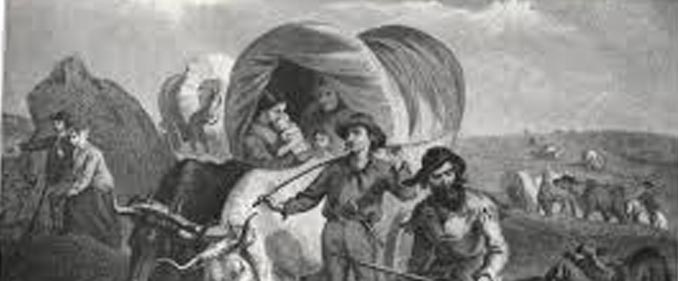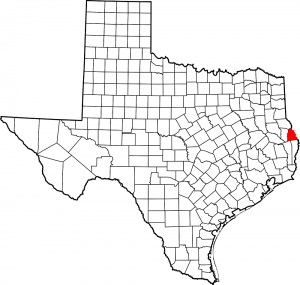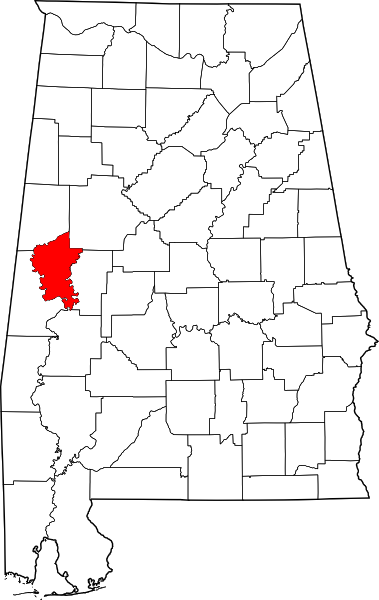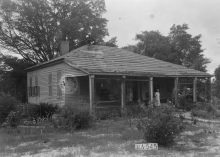[This is quite a story that reveals what travel was like in 1830]
 THE TRIP by BUD and TERRY ANDERSON
THE TRIP by BUD and TERRY ANDERSON
Excerpted and paraphrased by Pamela Anderson Thompson
(posted on Ancestry.com)
They carried all their possessions with them
Sometime between 1832 and 1834 a small caravan crossed the Sabine River out of northwestern Louisiana and rolled slowly into Texas. It had been a long and wearing trip for the adults, the horde of children and probably a handful of slaves led by Benjamin W. Anderson, the patriarch in his mid 80’s who was making his last great pilgrimage. The people with him were his sons, daughters and their families. They carried all the possessions and necessities for the trip that they could load onto the wagons.
There were approximately 33 members of the family who made the trip from Greene County, Alabama to Texas. There were about eight adults, four teenagers and at least 18 children under 10 years old As many as five children were babies under a year old. Many of the women were pregnant. It is one thing for a large body of adults to make such a trek, but more than half of this party were children. This was a children’s crusade lead by a handful of adults.
Greene County, Alabama
They all survived
If Benjamin and his tribe brought slaves, they were sorely needed, not only for the heavy work of driving livestock, driving the wagon and getting the wagons across fords, out of mud holes and up hills. Also, someone had to set up camp, prepare meals and keep the multitude of children out of trouble and accounted for. The journey had begun months earlier in Greene County on the western edge of Alabama. The party followed a track through land that was primeval: dense forest, untamed rivers and streams. After heavy rains the rivers were largely not fordable. There were swamps to cross and hills that tested the strength of both man and beast. Although hunger should not have been a problem for a resourceful party, illness, injury and even death was a specter that walked with them every mile. As far as we know, they all survived. …
The trek was 450-500 miles walking into the unknown
In “The Texas Republic” William Ramsom Hogan pointed out that many immigrant families were practically self-sufficient en-route, for their carefully hoarded stocks of food were supplemented by game. Travelers were also advised to bring furniture, cooking utensils, wagons, farming implements, tools, and provisions of food and clothing with them in order to begin their new life with less hardship. This was a trek: 450-500 hard miles, day after day, walking into the unknown. It could be regarded as high adventure, although probably only the youngest considered it so. This journey could not have taken less than two to three months under the best of conditions in the 1830s. It is also quite possible that the party spent some time visiting daughters Elizabeth and Susannah in Mississippi.
We don’t know the trail they followed, but today Interstate 20 runs a close appropriate path of least resistance through Alabama, Georgia, Mississippi and Louisiana, overlaying roadbeds and Native American trails. Almost certainly they would have had to cross the Mississippi on a ferry. The most likely places are Vicksburg, Natchez or Baton Rouge. Vicksburg seems most appropriate because it is on the straight-line route from where they started the trip. This would also have pointed the party towards Natchitoches, Louisiana, an important trading center of the era. There they could have rested and replenished supplies before heading southwest down a well-traveled road, corresponding approximately to today’s State Highway 6 in Louisiana (Hwy 21 in Texas). And to Gaines Ferry across the Sabine River. This road is an extension of the historic El Camino Real and traces of it can still be seen.
They would have entered Sabine County, Texas
The Anderson’s would have entered Texas in Sabine County. There is some evidence that many remained in Sabine County before purchasing land in Nacogdoches County. This passage from Eutaw, Alabama to Nacogdoches, Texas made use of trails and paths used for years by earlier travelers and takes advantage of established communities and trading centers. Even if they didn’t buy or barter, it offered civility and relatively safe resting places. There’s no written record about their arrival, stepping off the ferry into Texas. Family lore has it that they arrived in December, 1834: old Ben, Jane, children, grandchildren and slaves. It would be romantic to call them pioneers, but they were farmers, people of their times. They moved with relative frequency on the heels of others who neutralized the most serious dangers of a new frontier. The Andersons move in order to acquire land on the outskirts of nation moving West.
The size of the family dictated the relocation. Benjamin may have worried that he didn’t have enough land to give all his children a suitable place to live. Also, cotton and corn deplete the soil and his crops may have been declining. Whatever the reason, Texas and its generous land policies under Mexican and Texas rule offered a great opportunity for farmers. Abraham Anderson, Benjamin’s grandfather accepted 200 acres on the Carolina coast in 1764 from King George III.
They settled in Berkeley County, South Carolina, and stayed until the threats of war from Spain were resolved and most of the Cherokee Indians had been removed by purchase and treaty. They participated in a land rush to settle the Up country and the Piedmont. Benjamin stayed in South Carolina (probably on more free land) in Newberry County in the Ninety-Sixth District, and then accepted 900 acres from the new state of Georgia on the Ocheegee River in Greene County late in the 1790s after 40 years in Alabama in Jones and Greene Counties.
Benjamin purchased land in Nacogdoches County
Moving to Texas, he was eligible to receive a league and a labor for having settled prior to Texas becoming a republic in 1849. This time, however, Benjamin purchased land in Nacogdoches County in what was called Black Jack. In his lifetime Benjamin Anderson moved halfway across the continent, from tidewater South Carolina to Georgia to Texas. He participated in one way or another in two major uprisings, the American Revolution in 1775-6 and the Texas Revolution in 1835-36. He moved always to the edge – a borderer. Whether by instinct or circumstances, this was his fate. He was born the subject of an English King and died a Texan.
– Additional notes: My father, Irving (Andy) Anderson said that his great-great Grandfather, Benjamin Anderson sired 25 children with two wives. This is a story of a pilgrimage with his second wife, children and grandchildren from Alabama to Texas in 1834.
Writing verbatim an interview published in the Portales, New Mexico News in 1906. SEVENTY TWO YEARS IN TEXAS May I step in and talk a few minutes with the old pioneers of Texas. We moved to Texas in the year 1834 from Green County Ala. and landed in Sabine County and I lived there a while: from that place to San Augustine County, there to Nacogdoches County where I spent most of my young days. MY fathers name was Benjamin Anderson. He was the father of twenty-five children, nine by his first wife and sixteen by my mother, but that large family has all passed to the great beyond except myself and one brother, George W. Anderson of Mason County Texas. I am 83 years old and my brother 81. After leaving Nacogdoches County I lived in the following counties; Navarro, Wise, Parker, Jack, Menard, and Schleischer. I have seen all the hardships of an old Texan. The only counties organized when we landed in Texas were Shelby, Jasper, San Augustine, Sabine and Nacogdoches. I am now living with my baby girl and her husband Mr. and Mrs. J. B. Hext two miles south of Portales, N. M. and despite my age of 83 years I often walk to town after the mail and am doing fine for one of my age. If any of the old boys of my age are still living, would love to hear from them. I want to say here that I read the News in its infancy. wishing the News success, will just pick up my cane and be jogging along. Thomas Howard Anderson, Portales, N. M. Copy of article in possession of Michael Houck.
Check out historical books and novels by Donna R. Causey

ALABAMA FOOTPRINTS Pioneers: A Collection of Lost & Forgotten Stories
includes the following stories
- The Yazoo land fraud
- Daily life as an Alabama pioneer
- The capture and arrest of Vice-president Aaron Burr
- The early life of William Barrett Travis, hero of the Alamo
- Description of Native Americans of early Alabama including the visit by Tecumseh
- Treaties and building the first roads in Alabama.







Wow. My great great grandmother did that after her husband died in 1895, i dont know how many of her children went with her, my great grandfather was one of her younger children that was with her. He came back to alabama where he met and married my great grandmother in 1909.
Because the name Eutaw is unusual, I have suspected that Eutaw, Texas was connected.
From the Texas State Historical Commission website: (first paragraph)
EUTAW, TEXAS. Eutaw, two miles east of Kosse, was the most important town in southern Limestone County until the coming of the railroads after the Civil War. The town formed in the early 1840s during the Republic of Texas era and was said to have been named in honor of Eutaw, Alabama, birthplace of one of the new community’s original settlers. The settlement’s first church was the Salem Baptist Church, organized in 1855. Around the same time, L. E. Trevzant opened a local school. The town grew rapidly. By the eve of the Civil War it had four general stores, two churches, a tavern, a blacksmith shop, a stage depot, and a school. Adolph Harris, who later became famous as the owner of the A. Harris and Company department store in Dallas, opened his first store in Eutaw shortly after arriving there in the 1850s.
Was there a formal list of name’s for these traverlers ?
Donna, your articles are fascinating, and I look forward to them each day. I have most of your books and will continue to add to my collection as you publish. Thank you for sharing your knowledge in such an interesting way.
Pretty sure that I know some Anderson descendants in Sabine county, tx.
Papa told me that I’m from Alabama rather than Texas because when his family got to the Mississippi River (ox wagon) his mom (grandmother?) refused to cross the river. They returned to Alabama.
I’m sure this write-up would be very interesting, if it were not overshadowed by the over 100,000 Native Americans who were forcibly removed from Alabama between the years of 1830 and 1840 during the infamous “Trail of Tears.” Their hardship and challenges were extraordinary, too … real. And not by choice. Alabama Pioneers were not all white.
The Choctaw Nation of Indian won Worcester v Georgia in 1832 followed by the Nullification Crisis of the Georgia Compact of 1802 then followed by the Non-Intercourse Act of 1834 25 USC 177 which required the Removal of the Settlers and Squatters of Alabama from Choctaw Indian Nation of Indians Lands.
Chief Darby Weaver
The Tribal Leader
Everyone should know this already.
That’s why people migrated everywhere else in 1834 and later.
The story has been twisted. The law has not.
My family also made a move from Perry County, Al to Texas in the 1840’s after a period of time in or around El Dorado, Ark. They ended in Henderson County, Texas. I have marveled at the courage and stamina my so many great grandmother had to crawl in a wagon and ride that distance in her late 50’s – early 60’s . I would hate to be told I had to do that now that I am in my 60’s. I wonder did she have arthritis?
In 1995 I had the pleasure of seeing/ Talking to my Great Aunt Mrs. Levada Davidson. She took me from South Carolina to Oklahoma in a covered wagon. I wish that I had recorded this visit as it is now lost to history. It was amazing what these people went though and done in their lifetimes.
Note: Levada Davidson was 104 years old at the time of this conversation.
My ancestors moved from perry county alabama aswell in 1851…
My ancestors (Stagner Family) left Pike County, along with many other families, during the Reconstruction Period and moved to Wood County in Texas. I acquired a history book written about Wood County, TX residents based on 1850 – 1900 and read about hardships during the move West.
Benjamin was the brother of my 4 times great grandfather Fredrick who fathered my 3 times great grandfather Ephraim who fathered my 2 times great grandfather D. A. (Doherty) who immigrated to Texas from Amite, Mississippi
And eventually ended up in Nacogdoches county near his relatives. One of his sons was my great grandfather Benjamin Underwood Holt Anderson who is buried in the same cemetery as his 2 times great uncle Benjamin in Blackjack cemetery in Nacogdoches County Texas.
Smart man to leave Greene county…. just look at it now.
Wonderful to have some facts to hang the story on! My ancesters left Lauderdale County, AL. about 1833-34 & moved to Madison County, Arkansas Territory. My 4x great grandparents, their 4 married children with their families & possibly 3 neighboring families. First Arkansas births in 1835. Wish we knew more!
my Morgan/Maness Clan did similar movin from Wilcox county AL to the Robertson Colony Area of TX in the 1830’s
The Non-Intercourse
Act of 1834 (25 USC 177) nullified any false notions of obtaining Indian Lands.
Chief Darby Weaver
The Tribal Leader